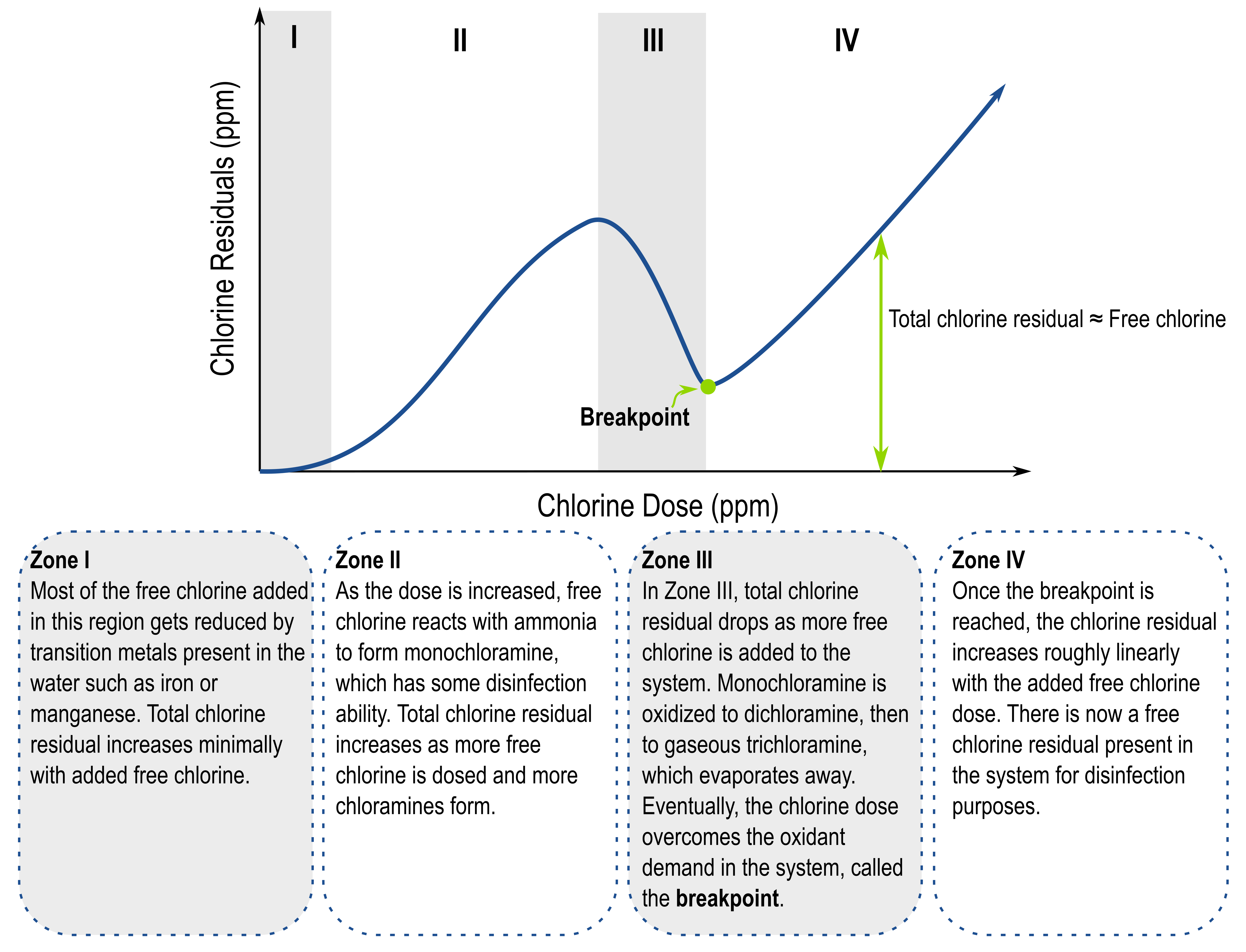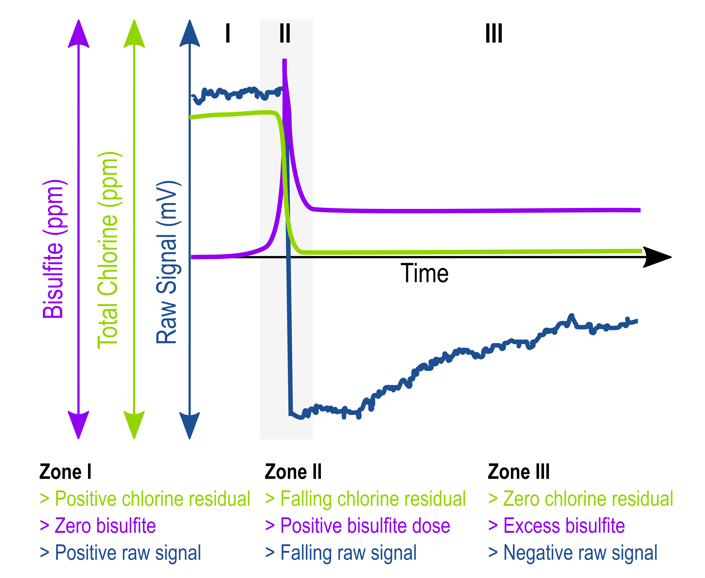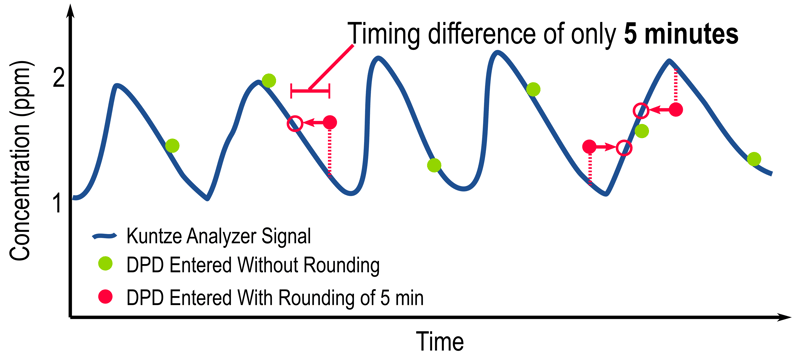Lacey Beck
Recent Posts
Understanding Breakpoint Chlorination
Breakpoint chlorination is important to understand for systems using chloramination, or in chlorination systems where ammonia might be present, such as wastewater systems.
Important Terms to Know
> Free chlorine: combination of Cl2, HOCl, and OCl-
> Combined chlorine: consists of mostly chloramines, which are formed when ammonia is added to free chlorine, yielding monochloramine (NH2Cl), dichloramine (NHCl2), trichloramine (NCl3), and organic chloramines
> Total chlorine: sum of free and combined chlorine

The shape of the curve and the relative concentrations depend on characteristics of your system such as temperature, pH, and what organic species are present. Still have questions? Contact a Kuntze representative to learn more.
Measuring Chlorine in Dechlorination Applications
Dechlorination is the removal of chlorine from water within a process before discharge. Most dechlorination systems use chemical reducing agents such as sulfur dioxide, bisulfite, or metabisulfite, which react with chlorine and convert it to chloride ions. Different regulations require a certain maximum chlorine residual of less than 0.5 ppm present before the water can be discharged to the environment.
Applications that regularly see 0 ppm disinfectant conditions have proven to be especially difficult for many measurement systems. Without disinfectant present, most applications see an increased presence of biogrowth, which covers electrodes, coats membranes, and clogs flow cells. Chemical reducing agents commonly used for dechlorination can interfere with the chlorine measurement.
Kuntze's measurement systems are designed to minimize influences caused by biogrowth. For the Zirkon® DIS probe (free chlorine) our patented ASR® automatic sensor cleaning technology can be triggered up to once a day to defend against biogrowth buildup. Both the Zirkon® DIS probe and the Zirkon® DIS Total probe (total chlorine) are robust enough to withstand manual cleaning as needed.
 The presence of reducing agents will cause the Zirkon® DIS Total probe to show a negative mV raw signal. This is normal and shows that you have a 0 ppm total chlorine residual (see the plot above). When operating at such low chlorine concentrations, it is important to understand the limitations of your reference measurement. Most reference systems are not capable of measuring less than 0.02 ppm.
The presence of reducing agents will cause the Zirkon® DIS Total probe to show a negative mV raw signal. This is normal and shows that you have a 0 ppm total chlorine residual (see the plot above). When operating at such low chlorine concentrations, it is important to understand the limitations of your reference measurement. Most reference systems are not capable of measuring less than 0.02 ppm.
Free vs. Total Chlorine
Free chlorine is the combination of Cl2, HOCl, and OCl-. Combined chlorine is formed when ammonia is added to free chlorine, yielding chloramines (mono-, di-, tri-, organic). Total chlorine is the combination of free and combined chlorine in solution.

For applications that contain no ammonia, a free chlorine measurement is appropriate. For applications where ammonia or chloramines might be present (e.g. wastewater and drinking water), a total chlorine measurement is appropriate.
The main difference is which probe you will use. The Kuntze Zirkon® DIS is for a free chlorine measurement, and measures the presence of only HOCl. The Kuntze Zirkon® DIS Total (right sensor shown) measures the presence of both HOCl and OCl-, which allows the analyzer to give a total chlorine measurement.
Be sure your reference measurement is configured to measure the correct parameter, and that you have purchased the correct reagents to do so. The free chlorine measurement works best below pH 8.5, while the total chlorine measurement is capable of going up to pH 10. If you have any further questions, please contact a Kuntze representative.
The Importance of Timing on Reference Measurements
Many applications have fast-moving oxidant concentrations, while others are more gradual. Regardless of the application, the timing of reference measurements is critical.

In the plot above, the Kuntze analyzer signal (blue line) matches well with the DPD measurements entered without rounding (green circles). The rounded DPD measurements (filled red circles) do not match with the Kuntze signal. If they had been entered without any rounding (empty red circles), they would have matched up. This plot shows how even small discrepancies (5 minutes or less) in the timing can affect the quality of the reference measurements.
To avoid timing errors, follow this procedure:
- Make a note of the time the sample is taken using the clock in the upper right-hand corner of the analyzer.
- Take your reference measurement as quickly possible.
- Enter your measurement using the time you noted in Step 1 without rounding the time.
